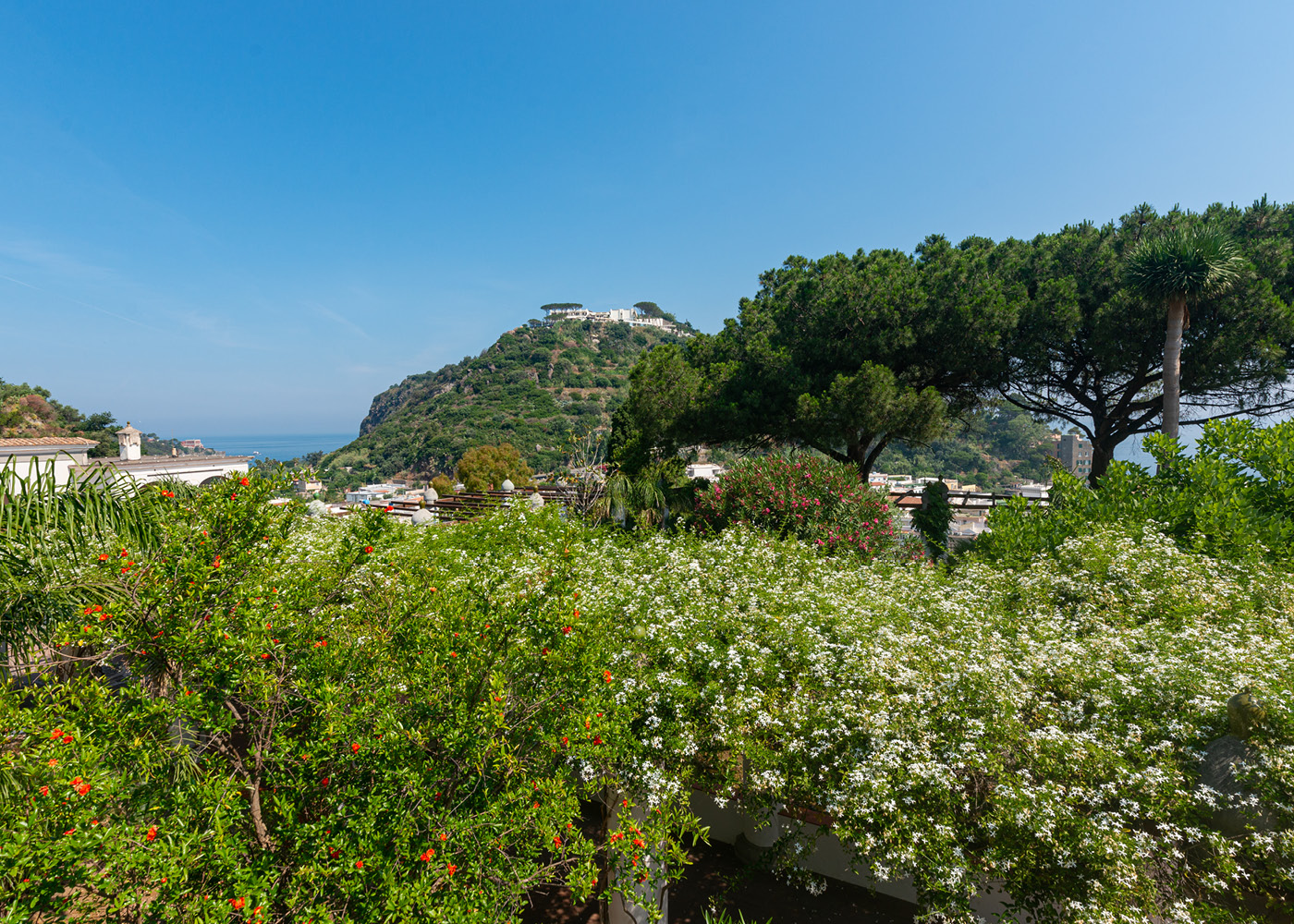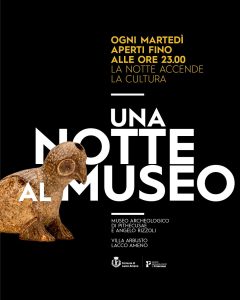
The island of Pithecusae: its history and myths
The historical tradition
Over the centuries, the island of Ischia, known in antiquity as Pithecusae (Pithekoussai in Greek), was a crossroads of the main trade routes that crisscrossed the Mediterranean. The island is visible from the mainland and its prosperity was due to its geographical position, its natural resources and the precocious development of craft activities including metalworking and pottery production.
The literary sources concur that the Greeks settled in Pithecusae in about 750 BC. They came from the island of Euboea (an island situated to the east of Attica) and a key role in this endeavour was played by the inhabitants of Eretria and Chalcis, the two most important Euboaean cities (Strabo V, 5-9). Control of the island, which endured the devastating effects of volcanic phenomena during the seventh century BC, fell into the hands of Cumae, the colony founded shortly after Pithecusae by the Euboaeans themselves (Livy VII, 22.5-6). According to ancient historians, a momentous clash between the Greeks and the Etruscans for the control of the Tyrrhenian Sea took place between the late sixth and early fifth century BC, culminating in the second battle of Cumae in 474 BC. Following the Greek victory, Ischia, which had been occupied by the troops of Hiero I of Syracuse, an ally of the Greeks, fell under the control of Neapolis. From its earliest origins (late sixth-early fifth century BC), Neapolis played a crucial role in the control of maritime traffic, to which its fortunes were closely linked.
During the second half of the fifth century BC, Campania, which had been inhabited since the Iron Age by various ethnic groups (Greeks, Etruscans and indigenous peoples), came under the control of Italic peoples who took over the area’s main cities. the Campanians occupied Capua and Cumae and only Neapolis managed to retain partial control of its independence. During this period and throughout the Hellenistic and Roman eras, Pithecusae remained a lively centre of production, especially of pottery and amphorae.
During the Roman period, the main settlement of the island, known as Aenaria, was situated on the east coast at Cartaromana where underwater excavations have brought to light a quay and finds that indicate the use of the mooring for commercial traffic.
The ancient sources
STRABONE, V, 5-9
Pithecusae was once settled by the Eretrians and the Chalcidians who, although they had prospered here on account of the fruitfulness of the soil and on account of the gold mines, abandoned the island as the result of a dispute; later on they were also driven out of the island by earthquakes, and by eruptions of fire, sea and hot waters… And Timaeus also says that many marvellous things are told by the ancients about Pithecusae, and that only shortly before his own time the hill called Epopeus (present-day Monte Epomeo), in the centre of the island, on being shaken by earthquakes, cast forth fire and shoved the part between it and the sea back to the open sea; and the part of the land that had been burned to ashes, on being lifted high into the air, crashed down again upon the island like a whirlwind; and the sea retreated for three stadia, but not long after retreating turned back and with its reverse current deluged the island; and consequently, the fire in the island was quenched, but the noise was such that the people on the mainland fled from the coast into Campania. The hot springs in the island are thought to cure those who have gall-stones.
LIVIO, VIII, 22.5-6
Palaepolis was a city not far from the present site of Neapolis. The two cities formed one community. The original inhabitants came from Cumae; Cumae traced its origin to Chalcis in Euboea. The fleet in which they had sailed from home gave them the mastery of the coastal district which they now occupy, and after landing in the islands of Aenaria and Pithecusae they ventured to transfer their settlements to the mainland.
Pithekoussai: “island of monkeys” or “island of vases”?
With regard to the origins and meaning of Pithekoussai – the Greek name of the island – different interpretations existed even in antiquity: the Alexandrian historian Xenagoras thought it derived from pithekos, the Greek word for “monkey” and linked the name to the legendary presence in Ischia of the Cercopes, two mythical Greek bandits who tried to rob the sleeping Heracles but, when they were discovered, they were tied upside down on a pole and turned by Zeus into monkeys. According to one authoritative hypothesis, the tradition of giving islands the names of wild animals (such as Capri, the ‘island of goats’) can be traced back to the sailors of antiquity who moved towards territories that were unknown and considered full of potential threats.
Pliny the Elder suggested another etymology: the name originated from “a figlinis doliorum”, in other words the pottery workshops (pithoi is the Greek word for vases) on the island which was a thriving centre for the production of pottery.
A third possibility has been put forward by D. Ridgway, one of the leading scholars of Ischian archaeology: the name Pithekoussai could simply be “the Graecised form of a pre-literate indigenous name for the island or its people (or possibly the whole of the Phlegraean archipelago comprising Ischia, Procida and Vivara). Islands and ports are particularly susceptible to this treatment by foreign sailors and merchants to render outlandish names accessible to their own alphabets and palates: classic cases are the Italian ‘Orcadi’ (for the Scottish Orkneys) and the English ‘Leghorn’ (for the Italian Livorno)”. (D. Ridgway, The First Western Greeks, Cambridge University Press, 1992)
The other name of Pithecusae: Inarime – Aenaria
The name Inarime used to refer to the island is only found in poetic texts. It occurs for the first time in Virgil (Aeneid 9, 716); Virgil’s commentator Servius explains that it comes from Homer’s reference to Typhon’s confinement in Arima, the land of the Arimi (en Arimois: Iliad 11, 783), in other words, in the opinion of some scholars, beneath Ischia.
Aenaria was aready mentioned by the historian Lucius Cornelius Sisenna (Hist. Roman. Reliquiae, fragment 125) and is indicated as the second name of Pithecusae (Appian, B.C., V, 69). Many authors link the island to the voyage of Aeneas from Troy to Latium: the island unquestionably lay on the route of the wanderings of the Trojan hero. Several ancient authors state that the name Aenaria derived specifically from that of Aeneas (Pliny the Elder, Nat. Hist., III, 82 = 12, 2), although the etymology remains obscure.
Livy, (VIII, 22,5-6) mentions the “islands of Aenaria and Pithekoussai” as if they were place names that referred to two distinct islands. Pomponius Mela, II, 121 states that Aenaria was a distinct island, quite separate from both Procida and Pithecusae.
Pithekoussai and the myth of Typhon
The island’s volcanic nature and its geological features lie at the basis of Ischia’s association with the myth of Typhon, the rebellious giant who was confined to live beneath the island of Pithecusae as a punishment by Zeus: Typhon erupted fire, causing the waters to heat and, with his restless nature, provoked continuous earthquakes.
According to the poet Pindar (Pythian Odes, I, verses 13-28), like Aeschylus before him (Prometheus Bound, verses 351-372), the giant Typhon lay beneath the entire region between Etna and Cumae, thus linking the volcanic phenomena of Campania and Sicily. Several Roman authors, beginning with Virgil, categorically state that Typhon’s home was the island of Ischia.
(Aeneid, IX, 715-713)
“then at the sound lofty Prochyta trembles, and Inarime’s rugged bed, laid by Jove’s command above Typhoeus (Typhon)”
